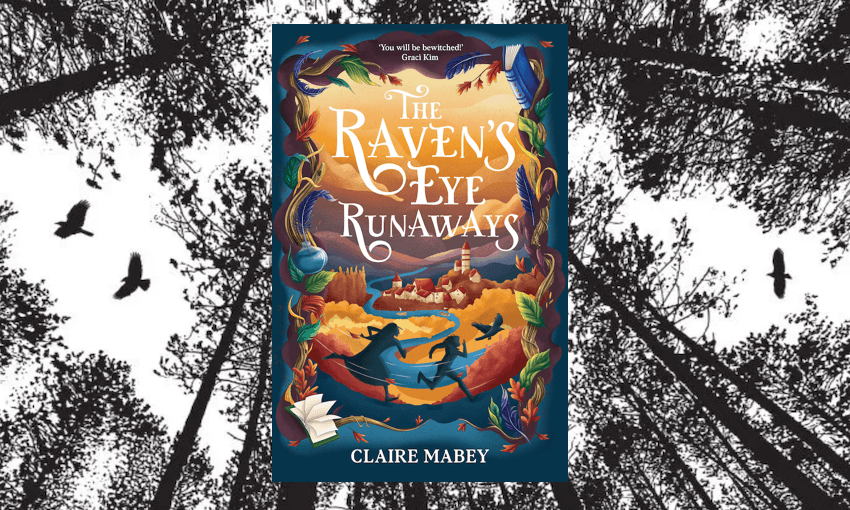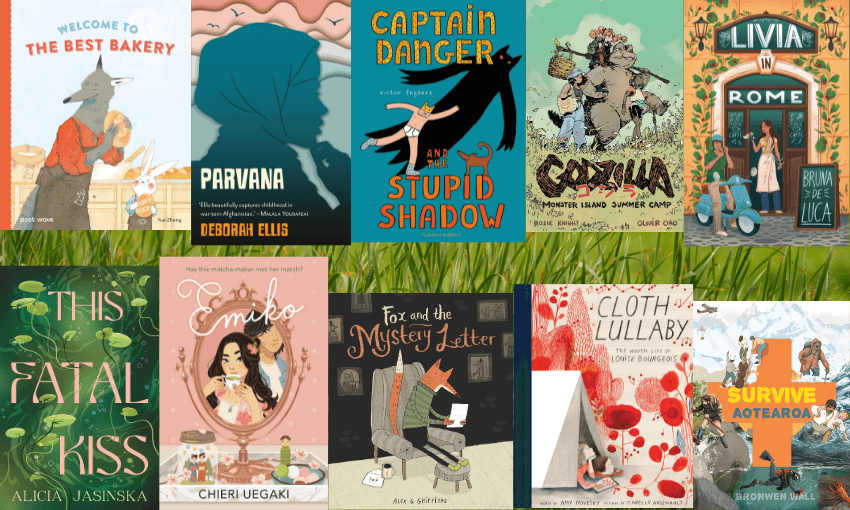Hera Lindsay Bird reviews the immersive debut novel from The Spinoff’s own books editor Claire Mabey.
“Glance at the sun. See the moon and the stars. Gaze at the beauty of the Earth’s greenlings. Now, think.”
This epigraph from Hildegarde Von Bingen, composer, philosopher, and Benedictine Abbess, is the perfect introduction to Claire Mabey’s debut novel. The Raven’s Eye Runaways asks the reader to gaze upon the beauty of the world. It asks us to see the sun and the moon and the stars. And it asks us to think.
“If you were to fly from Prime House to Missal House, your shadow would slide over meadows kept trim by clusters of cattle and sheep. You’d glide over villages with up-and-down roofs and follow one vast and busy river. sometimes your shadow would be rumpled by the twisted boughs of great old trees that seemed to be asleep.”
The book opens in a bookbindery in a parallel medieval world, “almost certainly after midnight.” Getwin Goode and her mother, of the Raven’s Eye Bookbindery in the village of Spitchwick, are working late into the night to meet an urgent deadline for a demanding client. Getwin’s good eye is weeping, and the only reward for her efforts is the promise of four-day-old plum cake. Although she and her mother bind books for a living, they are forbidden to read them, because only scholars are permitted to read, and scholars are born, not made. But despite the various indignities of running a small business, Getwin Goode is happy. She has a loving mother, a stalwart best friend, and a one-eyed raven called Sharp. And Getwin also has a secret. She knows how to read.
In the tower at Missal house, Lea’s tea isn’t delivered for the seventh morning. Her mind is growing clearer and clearer. Lea is a vessel “faithful to Prime.” The gift of script flows uncorrupted from her fingers. Later that day in the Scriptorium while transcribing Twelve Steps for the Discoverie of Strangers, Lea begins to see strange pictures appearing on her skin. A tree. A flock of birds. A hare with long ears. As she slowly awakens to the world, Lea begins to discover that Missal House, where she has lived for the past 13 years, isn’t what it seems.
“The moon was directly above the oculus. It cast a blazing silver beam over the stone floor, over Lea’s thin sheet until it reached her face. She blinked awake and shrank in its cold light. Her heart beat crazily as if it wanted to rise up out of her chest and fly away to join the night… Was she going to do this? Was she going to unlock the door and sneak all the way down to the kitchens?”
With the help of an unlikely ally, and a mysterious book called The Book of Green, which can communicate with its reader, Lea escapes the walled garden of Missal House. Soon after, she stumbles upon Buckle, Getwin and Sharp, The trio are searching for Getwin’s mother, who was summoned to Harrowden Hall for questioning, leaving Getwin a forbidden Rule Book and a letter full of family secrets. Buckle and Getwin agree to hide runaway Lea, and the three children soon find their fates intertwined.
Mabey has a knack for writing character. In her essay on writing The Raven’s Eye Runaways, she says her “characters arrive whole like visions”, and I can feel the truth of that in her fond and precise rendering of them. Everyone has a rich and distinctive voice, from the tyrannical Keeper Carver, to Getwin’s secret Aunt Lolly, named after Sylvia Townsend Warner’s seminal green witch Lolly Willowes. My particular favourite is the dreamy and reverent Lea, who after 13 years under the watchful eye of Prime, hasn’t quite mastered the knack of ordinary life. She sees portents and agents of ill fate at every turn, fears the fiery retribution of angels, and is a brilliant foil for the ribald and down-to-earth Getwin and Buckle, who don’t quite know what to make of her. The three children have brilliant chemistry, and you watch their friendship unfolding effortlessly on the page.
The Raven’s Eye Runaways has a roving, omniscient third-person perspective, settling for a moment on someone’s consciousness, like a bird on a branch, before taking off again. Not only do we see the inner machinations of the characters, we get a chance to see how they are perceived by each other and those around them. Like this brilliant passage from the perspective of the Innkeeper:
“The other girl reminded him of a swan. Ho ho! But indeed she was tall. Tall, thin, long neck, hair dark as the all-seeing rooks that raked their beaks along the ridgelines and chimney pots. She had the eyes of one who’d spent time in the Scribe Houses. The way she seemed to see more than anyone else, as if the dark universe was just in front of her.”
As a children’s bookseller, I’ve noticed the majority of contemporary middle-grade fiction is written in a limited third-person perspective, which like any literary technique, is good when done well, but can occasionally feel a little claustrophobic. In contrast, Mabey’s omniscient prose feels luxuriously spacious and self-assured, pausing occasionally to share a joke with the reader, before urging the eye onward like an invisible camera. The prevailing feeling is one of ever-unfolding complexity and veracity, as the truth of the world reveals itself, page by page.
There is a lightness and dexterity to Mabey’s prose. Like good medieval craftsmanship it’s both simple and ornate, or perhaps ornate in its simplicity. Easy enough for a young reader to approach with confidence, but with a slightly archaic, otherworldly clarity to it, reminiscent of contemporary writers like Kate DiCamillo, Adam Gidwitz or Frances Hardinge.
“The bookbinder’s mother is with a straight-haired girl with the mettle of a bear, in a house like a tower, with a thousand Strange voices chattering inside it.”
Most of all, this is a world that feels lived in.
As I get older, I find it harder and harder to suspend my disbelief. I don’t know whether this has to do with age, or whether this is the cascading effect of an increasingly self-referential culture, but I often find myself reading a book thinking “This sounds like a book”. I watch a movie and think “This feels like a movie”. But there’s something missing. Some animating breath. When it happens, I always wonder why.
My theory is that suspension of disbelief happens in the mind of the reader. But before it can happen in the mind of the reader, it must happen in the mind of the writer, and be artfully translated onto the page.
Sometimes the failure is in the act of translation. The writer has invented a world they don’t yet have the skill to articulate. Other times, it feels like a failure of imagination. Like the author hasn’t inhabited their world deeply enough, before letting it loose on the reading public. Mabey’s book does both beautifully. The world she has created, and the characters that reside there, feel authentic and inevitable as if they have lived with her for a long time. The story is translated onto the page with wit, restraint and confidence. It’s a talented rendering of a beautiful world and I instantly capitulated to the reality of it.
Perhaps this is, in part, because The Raven’s Eye Runaways is such a powerfully atmospheric book. Full of the smell of the wind and the taste of a dried plum stone. And like all good children’s books, it has lavish descriptions of food. Freedom, cake and revenge is a pretty good approximation of what young readers want, and Mabey’s book has all three in abundance.
Perhaps revenge is too strong a word. The book keeps its promises, and the villains get what’s coming to them. But although the antagonists in this book are ultimately outwitted by the tenacity and courage of the children, the laws and institutions which empowered them are not so easily overthrown, leaving plenty of room for a sequel 👀.
Children are careful and attentive readers. When they fall in love with a book, it’s with forensic passion. They pay closer attention to the music of language and machinations of plot than the most obnoxious adult bibliophile. Like Mabey says of Getwin: “by the time she reached the final page…she expanded. As if somehow the book had made a room inside her and would reside there for the rest of her life.”
Mabey pays her young readers the highest compliment, by respecting their intelligence, compassion and capacity for language. She makes her book a room inside the mind of the reader. She asks the reader to think for themselves.
There is plenty to think about in this book. Readers might worry that a book with the church as an antagonist might fall prey to 21st-century smugness or result in a glib moral victory. But Mabey’s story, in the tradition of Pullman’s His Dark Materials, is much more interesting and complicated than that. Instead, the book raises a number of pertinent questions. Who is scapegoated by society and why? Who has permission to access and disseminate information? How do women survive in a society afraid of women’s power? What is the nature of Strangeness? What is the nature of Prime? Whatever conclusions the reader draws, this is a compassionate and intelligent book, full of a deep reverence for the world and those in it. And for miracles of all kinds, in whatever manner they occur.
The Raven’s Eye Runaways by Claire Mabey (Allen & Unwin, $25) is available from Unity Books Wellington and Auckland.



